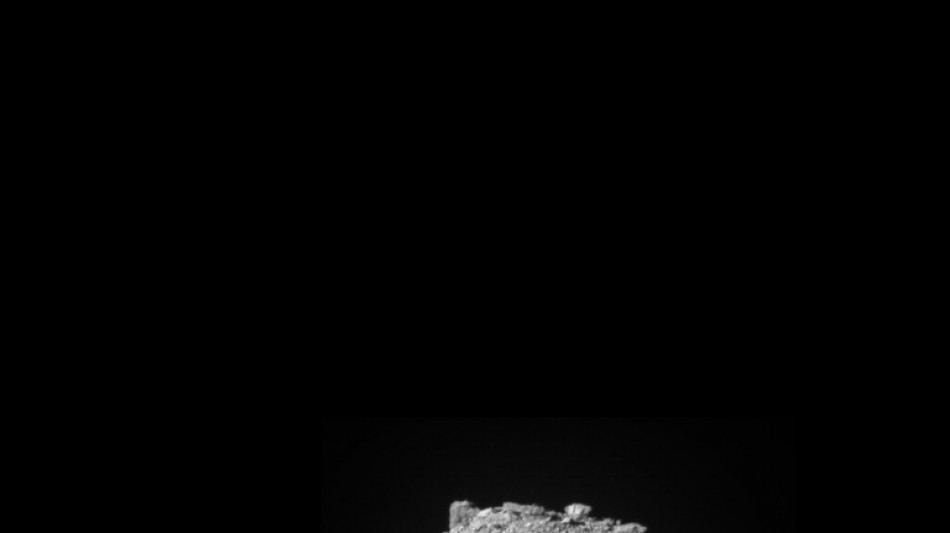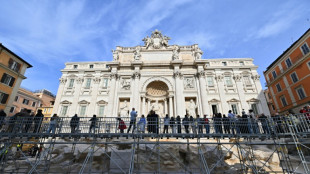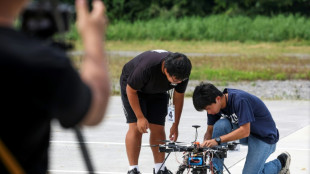
-
 Guardiola suffers four successive defeats for first time as Brighton rock Man City
Guardiola suffers four successive defeats for first time as Brighton rock Man City
-
Gauff fights back to beat Zheng for WTA Finals title

-
 Musiala sends Bayern ahead as rivals stumble
Musiala sends Bayern ahead as rivals stumble
-
Bangladesh outspin Afghanistan to level ODI series

-
 Monaco claim comeback win to retake second spot in Ligue 1
Monaco claim comeback win to retake second spot in Ligue 1
-
'Way too far': Amsterdam in shock after 'frightening' violence

-
 Bonzi fells Norrie in Metz for first ATP title
Bonzi fells Norrie in Metz for first ATP title
-
Biden, Trump to meet at White House ahead of historic return

-
 Jorgensen the hero as Australia edge England in Twickenham thriller
Jorgensen the hero as Australia edge England in Twickenham thriller
-
Vinicius treble as Real Madrid crush Osasuna, Villarreal rise

-
 A 'jungle': Rome's teeming jail lays bare Italy's prison ills
A 'jungle': Rome's teeming jail lays bare Italy's prison ills
-
Asalanka knock seals four-wicket Sri Lanka win over New Zealand

-
 Australia beat England 42-37 in Twickenham thriller
Australia beat England 42-37 in Twickenham thriller
-
Wolves end wait for Premier League win, Man City aim to snap losing streak

-
 Gaza mediator Qatar bows out, source says, in sign of impasse
Gaza mediator Qatar bows out, source says, in sign of impasse
-
Musiala stars as Bayern go six clear, Dortmund lose again

-
 'Racing career: completed it!' announces cycling great Cavendish
'Racing career: completed it!' announces cycling great Cavendish
-
Waring holds one-shot Abu Dhabi lead as McIlroy struggles

-
 Vinicius treble helps Real Madrid crush Osasuna
Vinicius treble helps Real Madrid crush Osasuna
-
Iran urges Trump to change 'maximum pressure' policy

-
 Goal-shy Lecce fire coach Gotti
Goal-shy Lecce fire coach Gotti
-
Comeback king 'Cav' set a benchmark doing the thing he loved

-
 UK's Queen Camilla to miss events as Kate returns to public life
UK's Queen Camilla to miss events as Kate returns to public life
-
Cycling great Cavendish announces retirement

-
 Rome's Trevi Fountain unveils tourist catwalk during cleaning
Rome's Trevi Fountain unveils tourist catwalk during cleaning
-
Defence puts a smile on All Blacks faces ahead of French Test

-
 Kagiyama wins NHK Trophy despite early slip
Kagiyama wins NHK Trophy despite early slip
-
Afghan women not barred from speaking to each other: morality ministry

-
 China's Xi hails 'new chapter' in relations with Indonesia
China's Xi hails 'new chapter' in relations with Indonesia
-
Injured Darry out of All Blacks tour with Cane in doubt

-
 Pakistani separatists kill 26 in railway station blast
Pakistani separatists kill 26 in railway station blast
-
China's Xi meets Indonesian president in Beijing

-
 Key nominees for the 2025 Grammy Awards
Key nominees for the 2025 Grammy Awards
-
Top art collector displays rare treasures in Madrid

-
 Pakistani separatists kill 25 in railway station blast
Pakistani separatists kill 25 in railway station blast
-
South Sudan floods affect 1.4 million, displace 379,000: UN

-
 Japan's Sasaki set to follow Ohtani with move to MLB
Japan's Sasaki set to follow Ohtani with move to MLB
-
Konstas hits unbeaten 73 in audition to open for Australia

-
 Pakistani separatists kill 22 in railway station blast
Pakistani separatists kill 22 in railway station blast
-
No culprit found five years on from Notre Dame fire

-
 Reeking mud sparks health fears in Spain flood epicentre
Reeking mud sparks health fears in Spain flood epicentre
-
Bogusz goal edges LAFC past Whitecaps in MLS playoffs

-
 N. Korea jams GPS signals, affecting ships, aircraft in South
N. Korea jams GPS signals, affecting ships, aircraft in South
-
Indonesia volcano catapults vast ash tower into sky

-
 Cavs ride huge first half to crushing win over Warriors
Cavs ride huge first half to crushing win over Warriors
-
Over 130 homes lost in California wildfire as winds drop

-
 New tools give researchers hope for fungus-ravaged US bats
New tools give researchers hope for fungus-ravaged US bats
-
Germany marks 1989 Berlin Wall fall with 'Preserve Freedom' party

-
 Heat, air pollution, disease: How climate change affects health
Heat, air pollution, disease: How climate change affects health
-
Boeing to face civil trial over 2019 MAX crash


NASA spaceship deflected asteroid in test to save Earth
NASA on Tuesday said it had succeeded in deflecting an asteroid in a historic test of humanity's ability to stop an incoming cosmic object from devastating life on Earth.
The fridge-sized Double Asteroid Redirection Test (DART) impactor deliberately smashed into the moonlet asteroid Dimorphos on September 26, pushing it into a smaller, faster orbit around its big brother Didymos, said NASA chief Bill Nelson.
"DART shortened the 11 hour 55 minute orbit to 11 hours and 23 minutes," he said. Speeding up Dimorphos' orbital period by 32 minutes exceeded NASA's own expectation of 10 minutes.
"We showed the world that NASA is serious as a defender of this planet," added Nelson.
The asteroid pair loop together around our Sun every 2.1 years, and pose no threat to our planet.
But they are ideal for studying the "kinetic impact" method of planetary defense, in case an actual approaching object is ever detected.
DART's success as a proof-of-concept has made a reality of science fiction -- notably in films such as "Armageddon" and "Don't Look Up."
Astronomers rejoiced in stunning images of matter spreading out thousands of miles in the wake of the impact -- pictures collected by Earth and space telescopes, as well as a mini satellite that had traveled to the zone with DART.
- Pseudo-comet -
Thanks to its temporary new tail, Dimorphos, which is 530-foot (160-meter) in diameter or roughly the size of a big Egyptian pyramid, has turned into a manmade comet.
But quantifying just how well the test worked required an analysis of light patterns from ground telescopes, which took a few weeks to become apparent.
The binary asteroid system, which was around 6.8 million miles (11 million kilometers) from Earth at impact, is visible only as a single dot from the ground.
Ahead of the test, NASA scientists said the results of the experiment would reveal whether the asteroid is a solid rock, or more like a "rubbish pile" of boulders bound by mutual gravity.
If an asteroid is more solid, the momentum imparted by a spaceship will be limited. But if it is "fluffy" and significant mass is pushed at high velocity in the opposite direction to impact, there will be an additional boost.
Never actually photographed before, Dimorphos appeared as a speck of light around an hour before impact.
Its egg-like shape and craggy, boulder-dotted surface finally came into clear view in the last few moments, as DART raced toward it at roughly 14,500 miles (23,500 kilometers) per hour.
- Mass extinction -
Very few of the billions of asteroids and comets in our solar system are considered potentially hazardous to our planet, and none are expected in the next hundred years or so.
But wait long enough, and it will happen.
The geological record shows, for example, that a six-mile wide asteroid struck Earth 66 million years ago, plunging the world into a long winter that led to the mass extinction of the dinosaurs along with 75 percent of all species.
An asteroid the size of Dimorphos, by contrast, would only cause a regional impact, such as devastating a city.
Kinetic impact with a spaceship is just one way to defend the planet, albeit the only method possible with current technology.
Should an approaching object be detected early, a spaceship could be sent to fly alongside it for long enough to divert its path via using the ship's gravitational pull, creating a so-called gravity tractor.
Another option would be launching nuclear explosives to redirect or destroy an asteroid.
NASA believes the best way to deploy such weapons would be at a distance, to impart force without blowing the asteroid to smithereens, which could further imperil Earth.
P.M.Smith--AMWN



